George H.W. Bush
George H.W. Bush was the 41st President of the United States and served as vice president under Ronald Reagan. He was also the father of George W. Bush, the 43rd President.
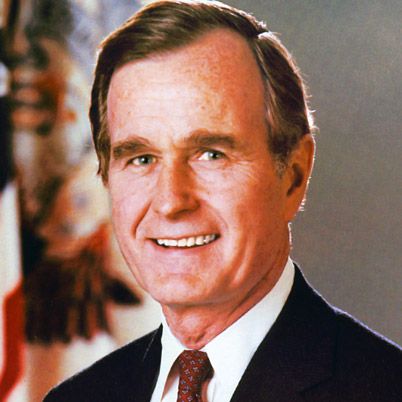
(1924-2018)

Who Was George H.W. Bush?
George Herbert Walker Bush was born on June 12, 1924, in Milton, Massachusetts. The son of Senator Prescott Bush, he was born into a wealthy and politically active family. Bush attended Phillips Academy, an elite boarding school in Andover, Massachusetts. He began dating his future wife, known as Barbara Pierce at the time, after they were introduced at a Christmas dance in 1941. Bush was 17 years old, and Barbara was just 16. They married in January 1945.
On his 18th birthday, Bush enlisted in the U.S. Navy, becoming the youngest pilot in the Navy during World War II. He served as a combat pilot in the war, flying carrier-based torpedo bomber aircraft and a total of 58 combat missions. He had a brush with death when his plane was hit during a bombing run in the Pacific. After managing to escape the burning aircraft, he was quickly rescued by a U.S. Navy submarine. Bush was awarded the Distinguished Flying Cross for his WWII service.
After the war, Bush attended Yale University, where he graduated with a degree in economics in 1948. He later moved to Midland, Texas, where he found success in the oil and petroleum industry.
Congressman and Vice President
Bush became chairman of the Harris County Republican Party in 1963. The following year, he ran an unsuccessful campaign for a U.S. Senate seat in Texas. It didn't take long for Bush to enter Congress, however; in 1966, two years after his unsuccessful Senate bid, he was elected to the U.S. House of Representatives, ultimately serving two terms. Bush was later appointed to several important positions, including U.S. ambassador to the United Nations in 1971, head of the Republican National Committee during the Watergate scandal, U.S. envoy to China, and director of the Central Intelligence Agency in 1976.
Bush then set his sights on the U.S. presidency but failed to win his party's nomination in 1980, losing it to his opponent, Ronald Reagan. Bush would make it to the White House soon after, however: He was chosen as Reagan's vice-presidential running mate. Reagan won the 1980 election, defeating Democrat challenger Jimmy Carter . He was re-elected in 1984, with Bush serving as his vice president for both terms.
Bush finally reached the White House's top seat in 1989; he won the 1988 election against Democratic nominee Michael Dukakis, becoming the first sitting vice president to be elected president since 1837. During his nomination acceptance speech at the 1988 Republican National Convention, Bush famously stated, "Read my lips: No new taxes."
Accomplishments
During his presidency, Bush skillfully handled foreign affairs during a tumultuous time for the nation. Just months into his first term, he responded to the dissolve of the Soviet Union and oversaw the U.S. military's removal of Panamanian dictator Manuel Noriega from power. Not long after, Bush responded to then Iraqi President Saddam Hussein 's invasion of Kuwait (August 1990), creating a national coalition and leading a military strike to drive Hussein out of the oil-rich country. Bush's handling of the invasion in Kuwait is largely viewed as his greatest presidential success.
Bush delivered a speech to the American public as the invasion began, stating, "Now the 28 countries with forces in the Gulf area have exhausted all reasonable efforts to reach a peaceful resolution. [We] have no choice but to drive Saddam from Kuwait by force. We will not fail. We are determined to knock out Saddam Hussein's nuclear bomb potential. We will also destroy his chemical weapons facilities. Much of Saddam's artillery and tanks will be destroyed. ... Our objectives are clear: Saddam Hussein's forces will leave Kuwait."
Despite his global successes, Bush's inability to handle economic problems at home were blamed for his re-election bid failure in 1992.
Post-Presidency
When his eldest son, George W. Bush, was elected president in 2000, Bush made many public appearances, frequently to speak in support of his son. In addition to being a proud and supportive father, he lent his support to several political causes. In 2005, he joined forces with former president Bill Clinton — the Democratic candidate who defeated him in the 1992 election — to help people affected by Hurricane Katrina, which devastated the Gulf Coast region, especially Louisiana and Mississippi. The Bush-Clinton Katrina Fund raised more than $100 million in donations in its first few months.
In 2011, Bush was honored with the Presidential Medal of Freedom by President Barack Obama .
Health Issues
In November 2012, an 88-year-old Bush was admitted to a Houston, Texas, hospital to be treated for a cough related to bronchitis. His cough reportedly improved, but he remained hospitalized because of other health setbacks. Bush developed a "persistent fever," according to an Associated Press report, prompting his move to an intensive care unit in December. That year, it also became known that Bush was suffering from lower-body parkinsonism, a disease that has confined him to a wheelchair.
The former president seemed to be in good spirits the following July. Photos released to the press showed Bush with a shaved head, in support of a Secret Service agent's young son who was battling leukemia. Bush and his wife also contributed to a special fund established to pay for the boy's medical expenses.
Bush was admitted to Houston Methodist Hospital in December 2014 after experiencing shortness of breath. In 2013, he had been hospitalized for two months following a bout with bronchitis. Despite his health setbacks over the years, Bush has skydived on a number of milestone birthdays since leaving the White House. His last jump was in June 2014, in celebration of his 90th birthday. He had previously parachuted for his 80th and 85th birthdays.
In July 2015, the 91-year-old former president fell at his summer home in Kennebunkport, Maine, and broke a vertebra in his neck. His medical condition was considered “not life threatening,” according to his spokesman.

On January 14, 2017, Bush was hospitalized again, suffering from "an acute respiratory problem stemming from pneumonia," according to a statement. His wife, Barbara, was hospitalized on January 18 after experiencing "fatigue and coughing," and was released on January 23. Shortly after, the resilient former president and his wife attended Super Bowl LI at NRG Stadium in their hometown of Houston. They were cheered on by the crowd when Bush performed the coin toss before the start of the game.
Shortly after Barbara died in April 2018, Bush was admitted to Houston Methodist Hospital with an infection that led to sepsis. He was placed in intensive care, where his condition reportedly stabilized. In late May, after returning to Maine for another summer, the former president again found himself in the hospital, this time due to low blood pressure and fatigue, but his strength soon returned and he was discharged after one week.
In late June, the nonagenarian showed that his playful sense of humor remained intact by donning a pair of Bill Clinton socks for a visit by his White House successor. Bush tweeted a photo of their get-together, captioned with: "Special visit today with a great friend — and now, a best-selling author. Luckily I had a freshly laundered pair of @BillClinton socks to mark the occasion."
Sexual Harassment Allegations
In late 2017, Bush was among the list of politicians and Hollywood bigwigs accused of sexual harassment. His alleged indiscretions dated back to at least 1992, though most of the accusations stemmed from more recent events. Bush’s spokesman, Jim McGrath, attributed the allegations to the wheelchair-bound former president being unable to reach above waist level when posing for photos with women.
On November 25th of that year, Bush officially became the longest living president in American history, at 93 years and 166 days. He surpassed the old mark held by Gerald Ford , with Ronald Reagan in third place, at 93 years and 120 days. After Bush's passing, Jimmy Carter became the longest living president.
Bush passed away on November 30, 2018, at 10:10 pm in Houston, Texas. "Jeb, Neil, Marvin, Doro, and I are saddened to announce that after 94 remarkable years, our dear Dad has died," his son George said in a statement. "George H. W. Bush was a man of the highest character and the best dad a son or daughter could ask for. The entire Bush family is deeply grateful for 41’s life and love, for the compassion of those who have cared and prayed for Dad, and for the condolences of our friends and fellow citizens."
Bush spent most of his time in Houston or at his home in Kennebunkport. He was married to Barbara for more than 70 years, during which time they had children George, Robin, Jeb, Neil, Marvin and Dorothy. Another daughter, Robin, died in 1953.
Barbara Bush
"],["
George W. Bush
Ronald Reagan
Saddam Hussein
"]]" tml-render-layout="inline">
QUICK FACTS
- Name: George Herbert Walker Bush
- Birth Year: 1924
- Birth date: June 12, 1924
- Birth State: Massachusetts
- Birth City: Milton
- Birth Country: United States
- Gender: Male
- Best Known For: George H.W. Bush was the 41st President of the United States and served as vice president under Ronald Reagan. He was also the father of George W. Bush, the 43rd President.
- U.S. Politics
- World Politics
- Astrological Sign: Gemini
- Phillips Academy
- Yale University
- Death Year: 2018
- Death date: November 30, 2018
- Death State: Texas
- Death City: Houston
We strive for accuracy and fairness.If you see something that doesn't look right, contact us !
CITATION INFORMATION
- Article Title: George H.W. Bush Biography
- Author: Biography.com Editors
- Website Name: The Biography.com website
- Url: https://www.biography.com/political-figures/george-hw-bush
- Access Date:
- Publisher: A&E; Television Networks
- Last Updated: October 17, 2019
- Original Published Date: April 2, 2014
- I have opinions of my own, strong opinions, but I don't always agree with them.
- Read my lips: No new taxes.
- I'm conservative, but I'm not a nut about it.
Watch Next .css-smpm16:after{background-color:#323232;color:#fff;margin-left:1.8rem;margin-top:1.25rem;width:1.5rem;height:0.063rem;content:'';display:-webkit-box;display:-webkit-flex;display:-ms-flexbox;display:flex;}

U.S. Presidents

Oppenheimer and Truman Met Once. It Went Badly.
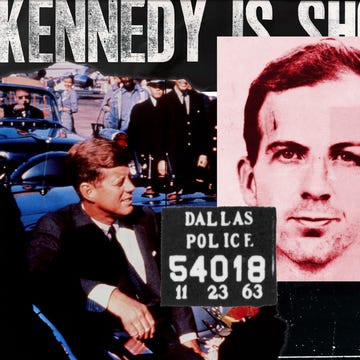
Who Killed JFK? You Won’t Believe Us Anyway

John F. Kennedy

Jimmy Carter
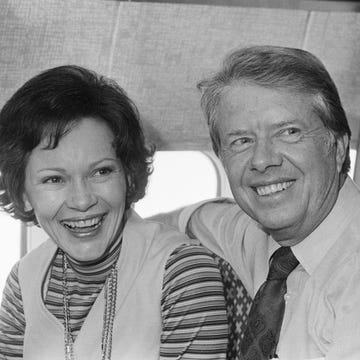
Inside Jimmy and Rosalynn Carter’s 77-Year Love

Abraham Lincoln
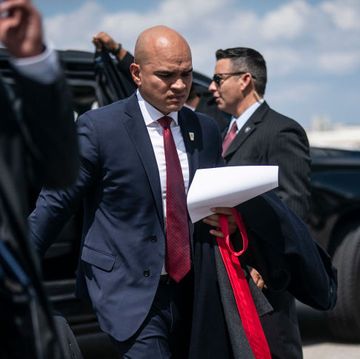
Who Is Walt Nauta, the Man Indicted with Trump?
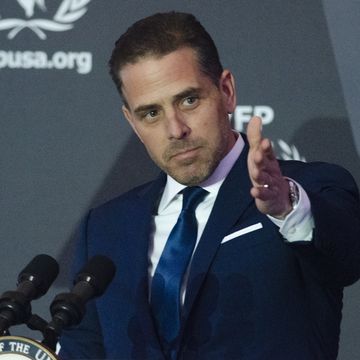
Hunter Biden and Other Presidential Problem Kids
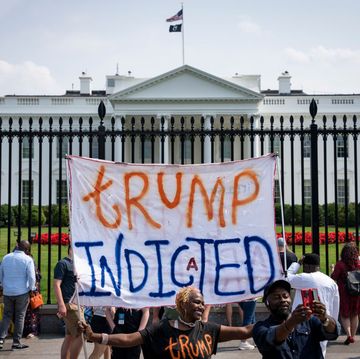
Controversial Judge Aileen Cannon Not Out Just Yet
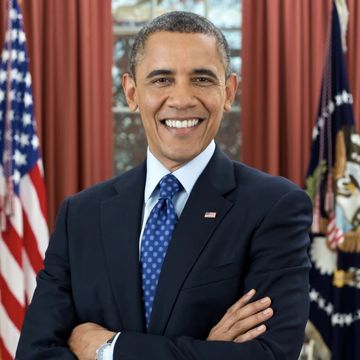
Barack Obama
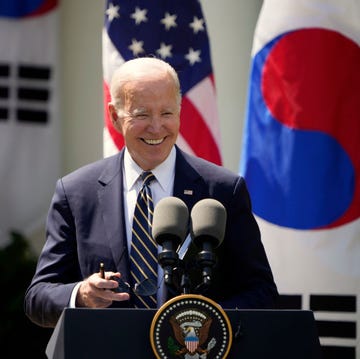
10 Celebrities the Same Age as President Joe Biden
Mobile Menu Overlay
The White House 1600 Pennsylvania Ave NW Washington, DC 20500
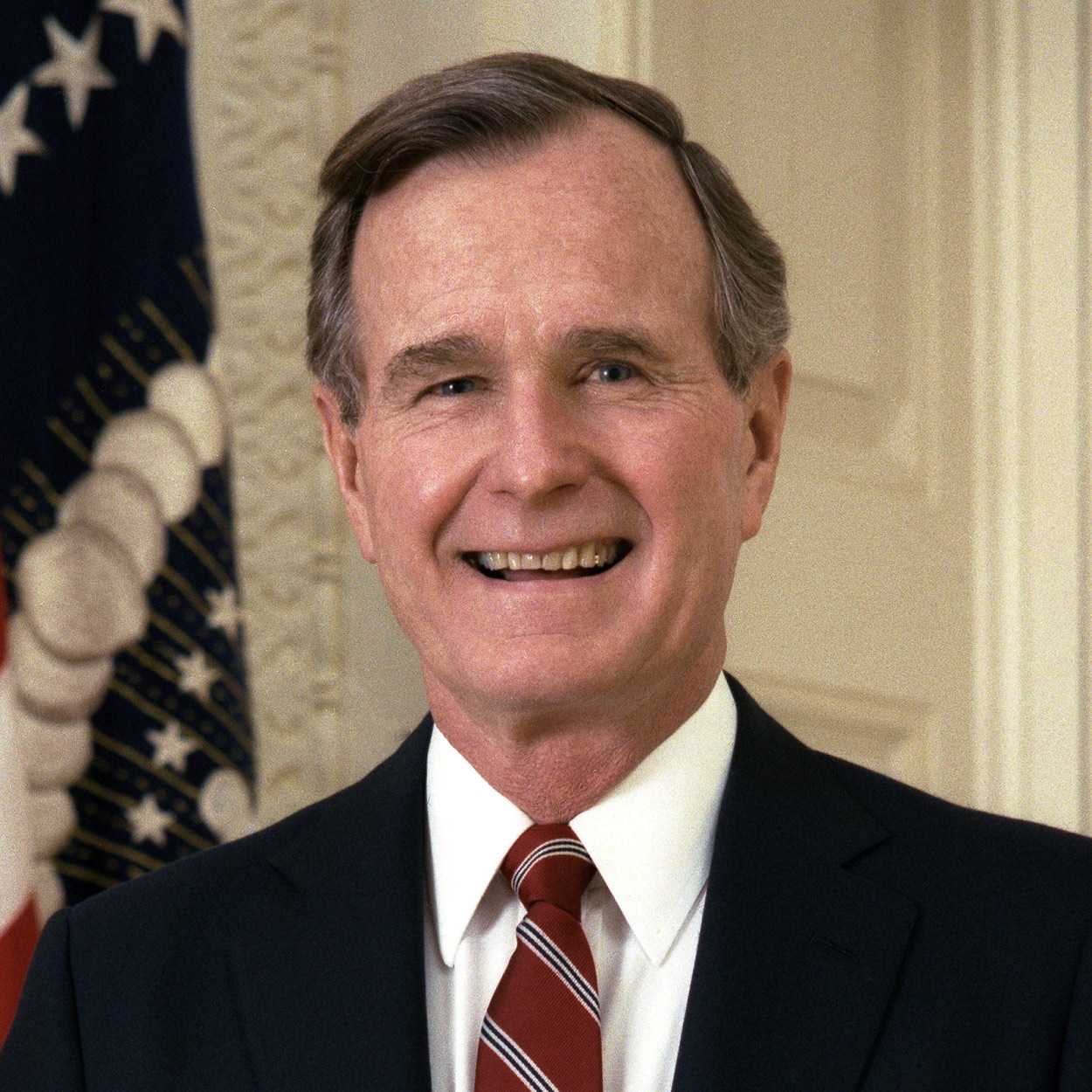
George H. W. Bush
The 41st President of the United States
The biography for President Bush and past presidents is courtesy of the White House Historical Association.
George H. W. Bush, as the 41st President (1989-1993), brought to the White House a dedication to traditional American values and a determination to direct them toward making the United States “a kinder and gentler nation” in the face of a dramatically changing world.
George Bush brought to the White House a dedication to traditional American values and a determination to direct them toward making the United States “a kinder and gentler nation.” In his Inaugural Address he pledged in “a moment rich with promise” to use American strength as “a force for good.”
Coming from a family with a tradition of public service, George Herbert Walker Bush felt the responsibility to make his contribution both in time of war and in peace. Born in Milton, Massachusetts, on June 12, 1924, he became a student leader at Phillips Academy in Andover. On his 18th birthday he enlisted in the armed forces. The youngest pilot in the Navy when he received his wings, he flew 58 combat missions during World War II. On one mission over the Pacific as a torpedo bomber pilot he was shot down by Japanese antiaircraft fire and was rescued from the water by a U. S. submarine. He was awarded the Distinguished Flying Cross for bravery in action.
Bush next turned his energies toward completing his education and raising a family. In January 1945 he married Barbara Pierce. They had six children– George, Robin (who died as a child), John (known as Jeb), Neil, Marvin, and Dorothy.
At Yale University he excelled both in sports and in his studies; he was captain of the baseball team and a member of Phi Beta Kappa. After graduation Bush embarked on a career in the oil industry of West Texas.
Like his father, Prescott Bush, who was elected a Senator from Connecticut in 1952, George became interested in public service and politics. He served two terms as a Representative to Congress from Texas. Twice he ran unsuccessfully for the Senate. Then he was appointed to a series of high-level positions: Ambassador to the United Nations, Chairman of the Republican National Committee, Chief of the U. S. Liaison Office in the People’s Republic of China, and Director of the Central Intelligence Agency.
In 1980 Bush campaigned for the Republican nomination for President. He lost, but was chosen as a running mate by Ronald Reagan. As Vice President, Bush had responsibility in several domestic areas, including Federal deregulation and anti-drug programs, and visited scores of foreign countries. In 1988 Bush won the Republican nomination for President and, with Senator Dan Quayle of Indiana as his running mate, he defeated Massachusetts Governor Michael Dukakis in the general election.
Bush faced a dramatically changing world, as the Cold War ended after 40 bitter years, the Communist empire broke up, and the Berlin Wall fell. The Soviet Union ceased to exist; and reformist President Mikhail Gorbachev, whom Bush had supported, resigned. While Bush hailed the march of democracy, he insisted on restraint in U. S. policy toward the group of new nations.
In other areas of foreign policy, President Bush sent American troops into Panama to overthrow the corrupt regime of General Manuel Noriega, who was threatening the security of the canal and the Americans living there. Noriega was brought to the United States for trial as a drug trafficker.
Bush’s greatest test came when Iraqi President Saddam Hussein invaded Kuwait, then threatened to move into Saudi Arabia. Vowing to free Kuwait, Bush rallied the United Nations, the U. S. people, and Congress and sent 425,000 American troops. They were joined by 118,000 troops from allied nations. After weeks of air and missile bombardment, the 100-hour land battle dubbed Desert Storm routed Iraq’s million-man army.
Despite unprecedented popularity from this military and diplomatic triumph, Bush was unable to withstand discontent at home from a faltering economy, rising violence in inner cities, and continued high deficit spending. In 1992 he lost his bid for reelection to Democrat William Clinton.
George H. W. Bush passed away on November 30, 2018, at the age of 94.
Learn more about George H. W. Bush’s spouse, Barbara Pierce Bush .
Stay Connected
We'll be in touch with the latest information on how President Biden and his administration are working for the American people, as well as ways you can get involved and help our country build back better.
Opt in to send and receive text messages from President Biden.
- Library and Museum
- George & Barbara Bush Foundation
- Museum Store
- Bush School
- George H.W. Bush's Biography
- Barbara Bush's Biography
- Causes & Interests
- Plan Your Visit
- Hours & Admission
- The Bush Family Gravesite
- The Grounds
- Frequently Asked Questions
- Museum Store
- Research Visits
- Helpful Links
- Current Rotating Exhibits
- Future Rotating Exhibits
- Permanent Exhibits
- Past Rotating Exhibits
- Museum Collections
- Make Field Trip Reservations
- Premier Programs
- Civics for All of US Distance Learning
- Storytelling Programs
- Scavenger Hunts
- Art & Essay Contest
- Additional Education Resources
- Summer Camp
- George & Barbara Bush Foundation
- Volunteer Opportunities
- Scholarships, Grants & Awards
- Presidential Library and Museum
- Internships
- Sponsored Programs
- News & Press
- Sign up for the Newsletter
George H.W. Bush

A World Transformed
Sworn in as the 41st President of the United States on January 20, 1989, George Herbert Walker Bush helped usher in a new and more hopeful geopolitical era marked by the spread of freedom and free markets. During his historic term in office, the West prevailed in the Cold War; the Soviet Union gave way to a democratic Russia; the Berlin Wall “fell” and Germany was unified within NATO; and President Bush signed two treaties to drastically reduce the threat of nuclear war. After Iraq’s unprovoked invasion of Kuwait in 1990, Mr. Bush forged an unprecedented coalition of disparate nations to uphold international law. His deft handling of this international crisis enabled him to convene the Madrid Peace Conference later in 1991. Throughout his presidency, George Bush worked closely with his international counterparts, including Soviet leader Mikhail Gorbachev, in ways that advanced America’s interests in peace and economic opportunity.
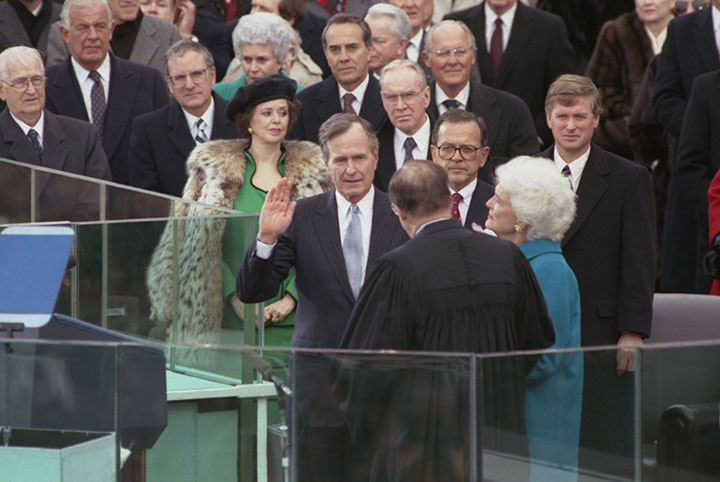
"To Make Kinder the Face of the Nation"
President Bush was the first sitting vice president to ascend to the presidency since 1837, and he was also only the second American president to serve a full term without party control in either chamber of Congress. Nevertheless, President Bush worked with Congress to pass the Americans with Disabilities Act and the Clean Air Act — landmark civil rights and environmental legislation. He also successfully fought for and negotiated the North American Free Trade Agreement (NAFTA), which was later signed into law. The education summit Mr. Bush hosted in 1989 with all 50 U.S. governors at the University of Virginia helped to spur a national reform movement. The 1990 budget agreement he signed codified into law real caps on discretionary spending by Congress while cutting the deficit by historic levels.
Points of Light
As president, Mr. Bush launched his “Points of Light” initiative to promote volunteerism and community service across America, and during his term in office he named 1,020 Daily Points of Light hailing from all 50 states. Long before he entered the political arena, however, he demonstrated his belief that “there could be no definition of a successful life that does not include service to others.” While at Yale, for example, he helped lead an annual charity fund drive that benefited the United Negro College Fund . In 1953, he helped establish the YMCA in Midland , Texas and served as chairman of the founding board. The Bushes also started the Bright Star Foundation to support cancer research following the death of their three year-old daughter, Robin, from leukemia on October 12, 1953.
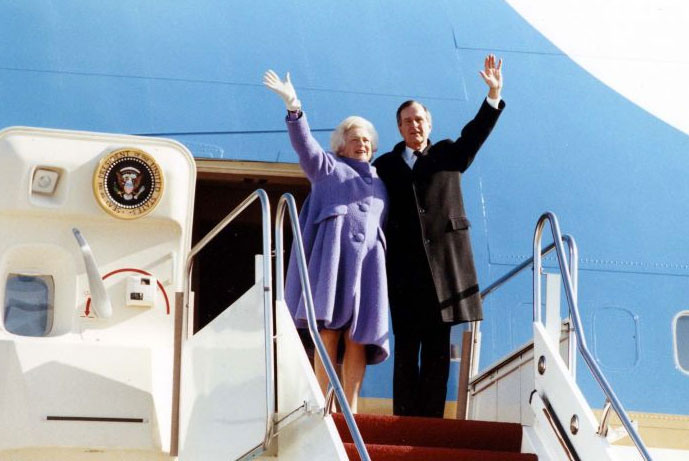
President George H. W. Bush has written two books – Looking Forward and A World Transformed – while his personal diary and other writings served as the basis for two additional books, All the Best and The China Diary of George H. W. Bush.

Looking Forward An autobiography; A World Transformed
Co-authored with General Brent Scowcroft, on foreign policy during his administration

All the Best
A collection of letters written throughout his life
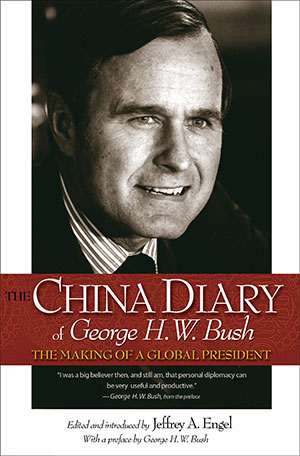
The China Diary of George H.W. Bush — The Making of a Global President.
In 2008, President Bush's diary, written during his time in China, was published under the title,
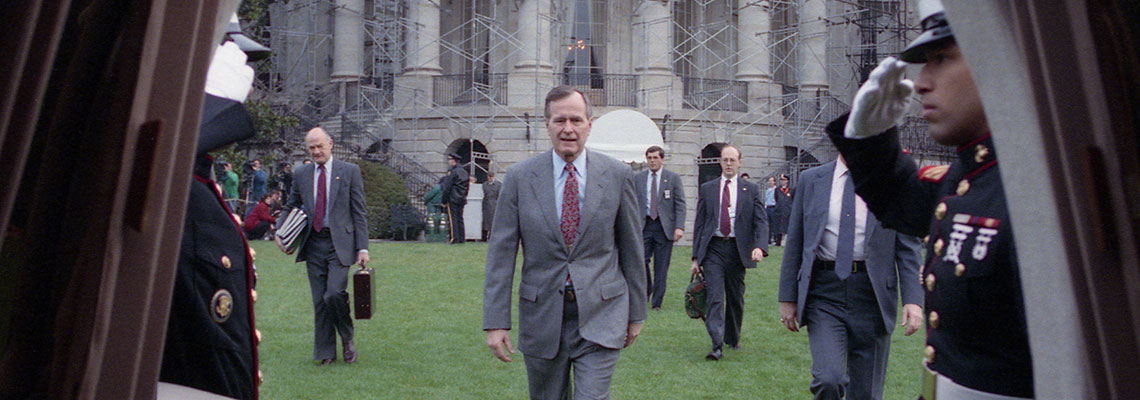
Spirit of Volunteerism
Since leaving office, President Bush has helped to raise hundreds of millions of dollars for charity. He served as chairman of the University of Texas’ M. D. Anderson Cancer Center Board of Visitors from 2001 to 2003, and the National Constitution Center in Philadelphia from 2006 to 2008. He was also named honorary chairman of the Points of Light Institute, the World Golf Foundation’s “First Tee” program, and C-Change, a coalition of cancer organizations. Of special note was his partnership with his successor, President Bill Clinton, to spearhead public awareness and financial relief efforts for victims of the 2004 Indian Ocean Tsunami , Hurricanes Katrina and Rita in 2005, and Hurricane Ike in 2008. In 2005, President Bush accepted an appointment from United Nations Secretary-General Kofi Annan as Special Envoy for the South Asian Earthquake Disaster following a devastating earthquake in Pakistan that claimed nearly 75,000 lives. He also teamed up with former Presidents Jimmy Carter, Bill Clinton, George W. Bush and Barack Obama to launch the One America Appeal for relief funds after the 2017 hurricane season devastated large swaths of Texas, Florida, Puerto Rico and the U.S. Virgin Islands
Relief Efforts
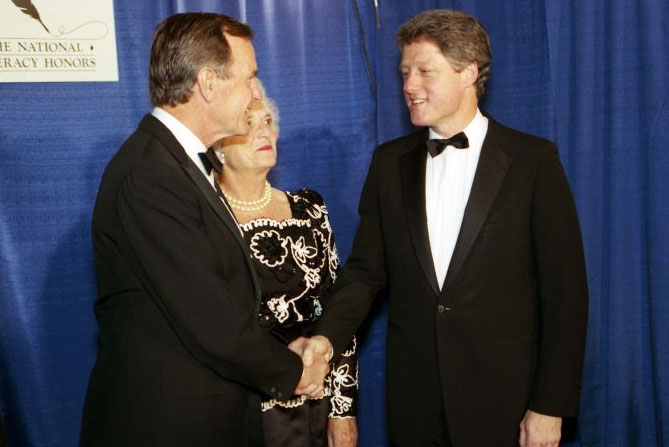
At the request of President George W. Bush, President Bush worked with President Bill Clinton to help raise funds to aid in the relief efforts following the catastrophic tsunami in Southeast Asia and Hurricane Katrina in the Gulf Coast states.
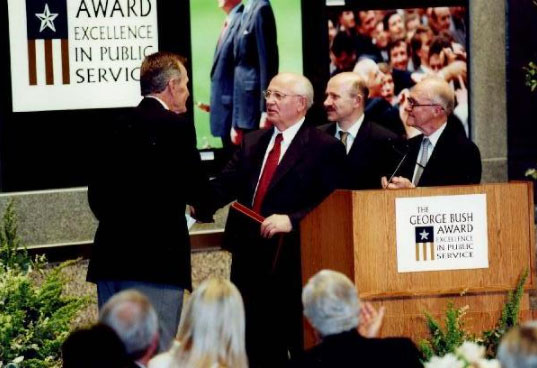
In 2006, he served as U.N. Secretary-General Kofi Annan's Special Envoy for the South Asia earthquake.
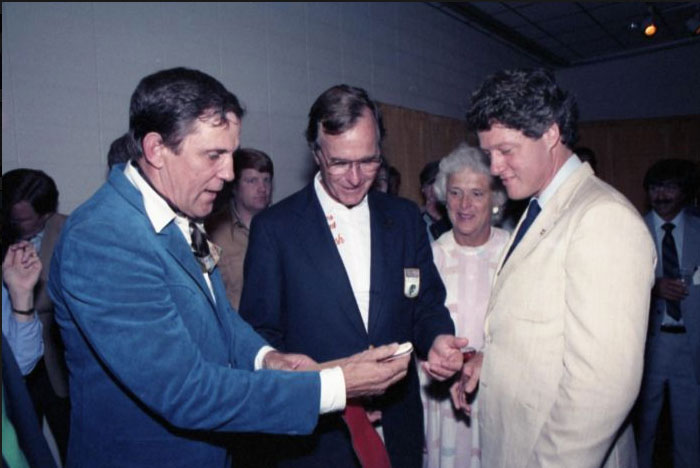
Following the destruction caused by Hurricane Ike on the Gulf Coast in September of 2008, President Bush again joined with President Clinton to form the Bush-Clinton Gulf Coast Recovery Fund to aid in the reconstruction of Gulf Coast infrastructure.
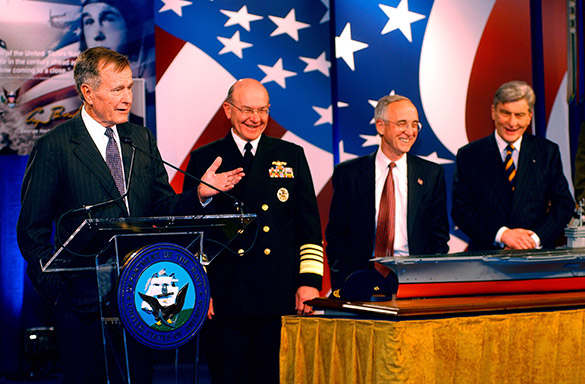
Special Honors
President Bush has received numerous honorary degrees and, after leaving the presidency, was awarded high honors from such nations as Kuwait, the United Kingdom, the Federal Republic of Germany, Nicaragua, Poland, the Czech Republic and Saudi Arabia. The Central Intelligence Agency headquarters in northern Virginia, Intercontinental Airport in Houston, and several elementary and high schools in Texas were named for the former president. The USS George H. W. Bush , which is the tenth and last of the Navy’s Nimitz-class supercarriers, was commissioned on January 10, 2009 at Norfolk Naval Station in Virginia and has deployed around the world in support of America’s foreign policy objectives. Finally, on February 15, 2011, President Bush accepted the Presidential Medal of Freedom from President Barack Obama during a White House ceremony .
Early Years
Born on June 12, 1924, in Milton, Mass., George Bush became a decorated naval pilot who flew torpedo bombers during World War II. He was shot down on September 2, 1944 while completing a mission over Chi Chi Jima Island and, tragically, lost his two crewmen William “Ted” White and John Delaney. By the time he was honorably discharged in September of 1945, Lieutenant Junior Grade Bush had logged 1,228 hours of flight time, 126 carrier landings and 58 combat missions. He was awarded the Distinguished Flying Cross, and the U.S. Navy Air Medal with two gold stars. Mr. Bush graduated Phi Beta Kappa from Yale University in 1948 with a degree in economics, and immediately moved to Texas with his wife Barbara and eldest son George W. to begin making his way in the oil business.
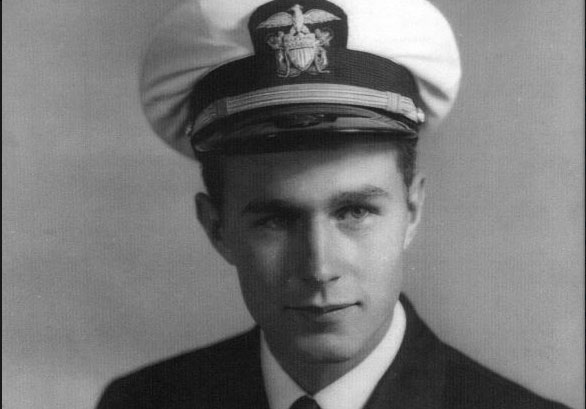

Political Career
President Bush's career in politics and public service began in February of 1963, when he was elected chairman of the Harris County (Texas) Republican Party. He was elected in 1966 to the U.S. House of Representatives from Texas' Seventh District and served two terms. Before serving as vice president from 1981 to 1989 under Ronald Reagan, President Bush held a number of senior-level positions: Ambassador to the United Nations (1971-1973); Chairman of the Republican National Committee (1973-1974); Chief of the U.S. Liaison Office in China (1974-1976); and Director of Central Intelligence (1976-1977).
Mr. Vice President
In 1980, Mr. Bush lost his first bid for the Republican presidential nomination to former California Governor Ronald Reagan, but accepted a spot on the GOP national ticket and served as the 43rd Vice President of the United States from 1981 to 1989. In that position, Mr. Bush managed federal deregulation and anti-drug efforts, and headed the Reagan administrations’ effort to combat terrorism. In foreign policy, President Reagan dispatched Vice President Bush at a pivotal and contentious time to help manage negotiations with key NATO allies leading to the deployment of Pershing II missiles in West Germany – a critical turning point in the Cold War. Flying from Texas to Washington, DC following the assassination attempt on President Reagan on March 30, 1981, Vice President Bush rejected a suggestion that he chopper directly from Andrews Air Force Base to the White House. “Only the president lands on the South Lawn,” he said, concerned about the worrisome impact such an irregular sight might have.
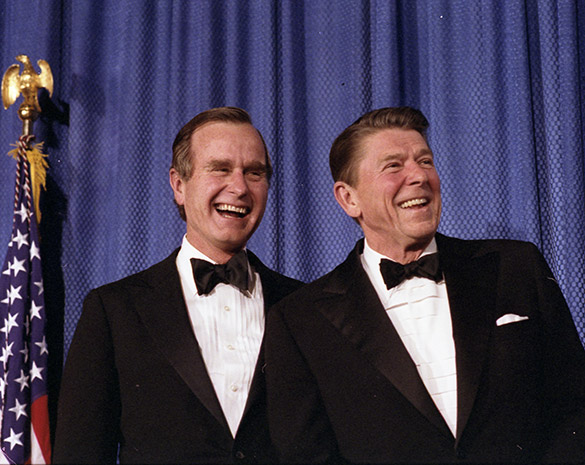
Family Life
George and Barbara Bush have five children, 17 grandchildren, and seven great-grandchildren. Their oldest son, George W., was sworn in as the 43rd President of the United States in 2001 and served two terms, returning to Texas in January 2009. Their son Jeb served as the 43rd Governor of Florida from 1999 to 2007. The Bushes have been married since January 6, 1945, and reside in Houston, Texas, and Kennebunkport, Maine. President Bush takes great pride that all of his children and grandchildren are active in their communities helping others.
- Skip to main content
- Keyboard shortcuts for audio player
Looking Back At George H.W. Bush's Legacy
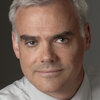
Scott Horsley
President George H.W. Bush has died at the age of 94. We look back on his life and legacy.
Copyright © 2018 NPR. All rights reserved. Visit our website terms of use and permissions pages at www.npr.org for further information.
NPR transcripts are created on a rush deadline by an NPR contractor. This text may not be in its final form and may be updated or revised in the future. Accuracy and availability may vary. The authoritative record of NPR’s programming is the audio record.

- Teacher Opportunities
- AP U.S. Government Key Terms
- Bureaucracy & Regulation
- Campaigns & Elections
- Civil Rights & Civil Liberties
- Comparative Government
- Constitutional Foundation
- Criminal Law & Justice
- Economics & Financial Literacy
- English & Literature
- Environmental Policy & Land Use
- Executive Branch
- Federalism and State Issues
- Foreign Policy
- Gun Rights & Firearm Legislation
- Immigration
- Interest Groups & Lobbying
- Judicial Branch
- Legislative Branch
- Political Parties
- Science & Technology
- Social Services
- State History
- Supreme Court Cases
- U.S. History
- World History
Log-in to bookmark & organize content - it's free!
- Bell Ringers
- Lesson Plans
- Featured Resources

Bell Ringer: President George H. W. Bush - Biography
George h.w. bush.
A brief summary of the life and career of George H.W. Bush.
Description
Bell ringer assignment.
- When was George H.W. Bush born? Describe his family life.
- Describe his military career.
- Who did he marry?
- Describe his work experience.
- In which offices did George H.W. Bush serve?
- Explain his rise to the presidency.
- How did people describe his personality?
- Describe the military conflict that occurred during his administration and the effect it had.
- How is he spending his years after leaving the White House?
Additional Resources
- On This Day: Operation Desert Shield and the beginning of the Gulf War
- Bell Ringer: Americans with Disabilities Act (ADA) of 1990
- Video Clip: George H.W. Bush Presidential Campaign Announcement
Participants
- Central Intelligence Agency
- Chichi-jima
- Persian Gulf
- Republican National Committee

- Afghanistan
- Budget Management
- Environment
- Global Diplomacy
- Health Care
- Homeland Security
- Immigration
- International Trade
- Judicial Nominations
- Middle East
- National Security
- Current News
- Press Briefings
- Proclamations
- Executive Orders
- Setting the Record Straight
- Ask the White House
- White House Interactive
- President's Cabinet
- USA Freedom Corps
- Faith-Based & Community Initiatives
- Office of Management and Budget
- National Security Council
- Nominations
President of the United States - George W. Bush
Biography of president george w. bush.
George W. Bush is the 43rd President of the United States. He was sworn into office on January 20, 2001, re-elected on November 2, 2004, and sworn in for a second term on January 20, 2005. Prior to his Presidency, President Bush served for 6 years as the 46th Governor of the State of Texas, where he earned a reputation for bipartisanship and as a compassionate conservative who shaped public policy based on the principles of limited government, personal responsibility, strong families, and local control.
President Bush is married to Laura Welch Bush, a former teacher and librarian, and they have twin daughters, Barbara and Jenna. The Bush family also includes two dogs, Barney and Miss Beazley, and a cat, Willie.
En Español
Graduate School
Career and public service.
- Owner, oil and gas business
- Partner, Texas Rangers Baseball Team
- Governor of Texas
- President of the United States
Related Links
- Vice President Cheney Biography
- Laura Bush Biography
- Lynne Cheney Biography

My Journey Through the Best Presidential Biographies

The Best Biographies of George H.W. Bush
07 Monday Jan 2019
Posted by Steve in Best Biographies Posts , President #41 - GHW Bush
≈ 9 Comments
American history , biographies , book reviews , George HW Bush , Herbert Parmet , Jon Meacham , presidential biographies , US Presidents

But now, despite his heroics in combat, his business acumen, his extraordinary capitalist grit and his unobtrusive but earnest political ambition, George H.W. Bush suddenly seems a quiet and unassuming figure from a long-passed era.
Bush 41’s presidency ended nearly a quarter-century ago but it still seems premature to consider the “best biographies” of him due, in part, to the recency of his death, his still-evolving legacy and the scarcity of biographies covering his life. And, in my opinion, the definitive biography of Bush 41 has yet to be written…
I read two biographies of Bush: a relatively dated book by noted historian (and author) Herbert Parmet and a much newer one by renowned biographer (and historian) Jon Meacham. In many ways the biographies are yin and yang , seemingly very different…but exceptionally complementary. Neither is ideal, but together they are clearly worth more than the sum of their parts.
* “ Destiny and Power: The American Odyssey of George Herbert Walker Bush ” (2015) by Jon Meacham
The author’s proximity to his subject is the defining feature of this biography. Meacham came to know Bush (and his family) extremely well during the decade-plus he spent writing this book. Meacham was even selected to eulogize Bush at his recent funeral. Thus, “Destiny and Power” affords readers the opportunity to see the world through Bush’s eyes. And in a very palpable way this biography reads like the memoirs Bush never wrote for himself.
But Bush’s pre-presidency passes too quickly and with too little depth. And while his presidency is covered at a more deliberate pace it often feels too forgiving. While Meacham is critical of Bush on occasion, pointing out flaws or failures, the book exudes an undeniable air of sympathy and affinity.
Nevertheless, Meacham is able to provide insight into Bush’s character and his world view that is likely to prove unique among Bush 41’s biographers – past and future. And although it failed to live up to my high expectations, this is a must-read on George H.W. Bush — 4 stars ( Full review here )
* “ George Bush: Life of a Lone Star Yankee ” (1997) by Herbert Parmet
Parmet was a long-time historian, professor and prolific author who died recently. His biography of Bush is not quite cradle-to-grave; it ends with the Bush presidency (leaving aside his retirement years and political legacy). But, otherwise, it is both comprehensive and thorough.
The best aspect of this biography is Parmet’s review of Bush’s early years. Nowhere have I seen better coverage of Bush 41’s ancestry, his military service, his congressional career, his service with the UN or the CIA. By comparison, Bush’s national political career is fine but not exceptional; pages devoted to President Bush’s response to Iraq’s invasion of Kuwait is particularly noteworthy, however.
What Jon Meacham does well in “Destiny and Power” tends to be in short supply here; Meachem sees the world from his subject’s perspective (but not from a distance) while Parmet observes events through a reporter’s eyes. To Parmet, things just happen ; understanding why is comparatively unimportant. For Meacham, understanding Bush’s mindset is of paramount importance; seeing things from an impartial third-party point of view is less critical.
In the end, Parmet’s and Meacham’s coverage of Bush’s life are surprisingly synergistic. But for Bush’s pre-presidency, Parmet’s coverage gets the nod — 3¾ stars ( Full review here )
Best Biography of George HW Bush: ***Too early to call***
Solid “One-Two” Punch: Parmet’s “George Bush” followed by Meacham’s “Destiny and Power”
Follow-up :
– “ George H. W. Bush: The American Presidents Series ” by Timothy Naftali
9 thoughts on “The Best Biographies of George H.W. Bush”
January 7, 2019 at 12:14 pm
Follow-up suggestion: 41: A Portrait of My Father by George W. Bush
January 7, 2019 at 12:19 pm
Thanks, great suggestion! For the moment I’m only including on my “follow-up” list biographies that veer toward history and away from memoirs / autobiography. But I do need to go back and read memoirs, autobiographies and books like this which provide a personal perspective inaccessible in traditional biographies.
January 7, 2019 at 12:25 pm
“When the World Seemed New” would be a good follow-up as well. It does cover his whole life, but the prime focus is Bush’s presidency, specifically his foreign policy and its impact on the world.
August 2, 2020 at 9:03 am
I agree “41” is a good follow-up, as offers a rare opportunity to read such a personal biography of one president written by another. It’s also a quick read, and Steve will can do it in one sitting. I also get that it is a bit of a memoir of W. himself. It can be put in it’s own sub-category of bios written by family members or close friends. I’ve just recently picked up Margaret Truman’s portrait of her father, after enjoying “41” so much.
January 7, 2019 at 10:50 pm
Steve, as one of the avid readers of your site, I can’t help but think that Bush I is one of those that I will probably have more choices than your’s by the time I get to certain presidents, due to my reading schedule (one bio per president, and four or five a year). I won’t hit Bush until 2026 and there are almost certain to be more bios of him by that time. Probably even a new Carter or two, not to mention Ford.
August 2, 2020 at 9:10 am
I like your pace, Teach! I am hopefully wrapping up my one-of-each this year, completing my journey that began in 2015. GHWB lived such a full, fascinating life, that it’s hard to imagine there won’t be some brilliant biographies to come. I’ve preordered Jonathan Alter’s new bio of Carter due out next month!
June 1, 2022 at 8:44 am
Suggestion to add to your follow-up list for POTUS 41: “The Man I Knew” by his post-presidency Chief of Staff, Jean Becker. It is one of my favorite president-related books I have ever read. My wife (who doesn’t read books often) and I both read it, and we both cried while reading certain portions of it. Not only is the book really informative (about POTUS 41, but also POTUS 43, 42 and 44), but it is quite inspirational. It made me long to have a man of that type of charcter in the White House again. It is more y about George H.W. Bush as a person than as a political figure, but it was an absolutely delightful read. One of my favorite books of any kind that I have read over the past decade.
February 5, 2024 at 11:36 pm
It might not be a traditional biography but how about What It Takes by Richard Ben Cramer? Focused on the 1988 election, but I think it goes pretty deeply into the backgrounds of the candidates including GHWB.
February 6, 2024 at 4:58 am
Great suggestion – I’ve never read this one and had almost forgotten about it until you mentioned it. Well…another post-it note with a good book idea going up on the wall… 🙂
Leave a comment Cancel reply

- Already have a WordPress.com account? Log in now.
- Subscribe Subscribed
- Copy shortlink
- Report this content
- View post in Reader
- Manage subscriptions
- Collapse this bar
President George Bush

- As of 2011, George and his wife Barbara have been married for 66 years, the longest of any presidential couple.
- George celebrated his 85th birthday by going skydiving.
- In 1993 he was knighted by Queen Elizabeth II . He was the third American president to receive an honorary knighthood.
- He was awarded the Distinguished Flying Cross medal while serving as a pilot in World War II.
- For a short time he worked as a professor at Rice University.
- Take a ten question quiz about this page.
- Listen to a recorded reading of this page:
Shiels: George H.W. Bush’s travels and character revealed in presidential books

Jean Becker spent 25 years as chief of staff for the late former President George H.W. Bush after he left the White House. She was a USA Today reporter who met Bush’s wife Barbara while editing a column for her during the 1988 campaign. After the election, Becker accepted a position in the First Lady’s press office during the president’s four-year tenure.
Becker’s devotion to the Bushes never ended, even to this day. She has published her second book celebrating the Bush legacy: “Character Matters…and other Life Lessons from George H.W. Bush.”
Becker’s first book: “The Man I Knew,” was her memoir of serving, which meant keeping up, with former President Bush.
“The man was the most energetic, outgoing person any of us ever knew,” Becker said. The fun, frenetic activity was also evidenced in the book I co-authored for President Bush’s golf professional and fishing buddy Ken Raynor, titled “I Call Him Mr. President – Stories of Golf Fishing and Life with my Friend George H.W. Bush.” Raynor’s book recounts Bushes trips to destinations such as St. Andrews, Scotland; the Arctic Circle; Puerto Rico; a cruise through the Greek Isles; and various PGA Tour events.
Becker worked closely with the busy President Bush, therefore she needed to spend summers in Maine and winters in Houston, where the Bushes lived in the Tanglewood neighborhood – where, just as in Kennebunkport, they received friends, celebrities and world leaders when they weren’t on the move.
Former British Prime Minister John Major is one of those who contributed a story for Becker’s “Character Matters.” I once spotted him walking through the George H.W. Bush Library and Museum, the tourist destination in College Station, Texas, near Houston, where the former President and First Lady are laid to rest. Presidential vehicles are on display, including “Fidelity,” one of the speedboats Bush piloted around the Atlantic off Walkers Point, his Kennebunkport, Maine compound of homes, a site which also draws tourists.
Russian President Vladimir Putin visited the #43rd President George W. Bush – and therefore his father, the #41st President – at Walker’s Point, Becker recalled wistfully with a joke.
“We were standing on the pier with the Atlantic Ocean right behind us. If I knew then what I know now, how easy it would have been to ‘accidentally’ push Putin into the ocean. Think of all the lives I could have saved! But I probably would have been shot.”
She revealed Putin and his Russian team were hosted in one of the Bush family homes on Walker’s Point called The Bungalow. “After they left, Mrs. Bush called the staff in to see they had totally trashed the house. There was a rotting fish in the kitchen and cigarette butts and, not to continue a stereotype: a lot of empty vodka bottles.”
Becker says President Joe Biden and Bush were friends. Bush planned to catch up with then vice-president Biden with a courtesy call to his hotel during a Biden trip to Houston – Bush’s hometown. The humble Bush squawked when Biden, mortified, respectfully suggested, though an aide, that protocol dictated he travel to former Bush’s home or office to greet him, a former president – not the other way around.
Becker says the humble Bush, in a phone call, told Biden’s nervous aide: “Here’s the problem young man. The vice-president has a motorcade that won’t even fit into my neighborhood. I have a two-car motorcade. This is logistics. I will go call on the vice-president, and you tell Joe that I said to ‘calm down.’”
Contact Michael Patrick Shiels at [email protected] His new book: Travel Tattler – Not So Torrid Tales, may be purchased via Amazon.com and his radio show is weekdays from 9-noon on WJIM AM 1240
Help inform the discussion
George H. W. Bush: Foreign Affairs
During his presidency, President Bush devoted much of his time to foreign affairs, an area over which Presidents generally have more latitude than they do with domestic affairs. In his first inaugural address, Bush spoke of unity between the executive and legislative branches in foreign affairs, presenting a united front to the rest of the world and referring to a time when "our differences ended at the water's edge." He also put together a team of advisers, including National Security Adviser Brent Scowcroft, Secretary of State James Baker, Secretary of Defense Dick Cheney, and chairman of the Joint Chiefs of Staff Colin Powell, who generally worked well together. President Bush approached foreign affairs with his characteristic conservatism and pragmatism. He did not rush into new actions or policy changes but gave himself time to consider the administration's policies. When he acted, he did so with firm conviction and determination. His past experiences gave him significant experience in foreign affairs, and he relied on the many contacts within the international community he formed as ambassador to the United Nations, U.S. envoy to China, director of Central Intelligence, and Vice President.
One example of Bush's conservative and pragmatic approach to foreign affairs occurred early in his administration. In June 1989, the Chinese military suppressed a pro-democracy movement demonstrating in Beijing's Tiananmen Square. Using tanks and armored cars, the military crushed the demonstrations and fired into the crowd, killing hundreds of protestors. Although Bush abhorred the Chinese government's violent crackdown in Tiananmen Square, he did not want to jettison improved U.S.-Sino relations by overreacting to events. Many in Congress cried out for a harsh, punitive response to the Chinese government's killing of peaceful protestors, but the Bush administration imposed only limited sanctions. Later in his administration, Bush sent Brent Scowcroft and Lawrence Eagleburger, deputy secretary of state, to China to try to repair the damaged, but not destroyed, relationship. In the end, U.S.-Sino relations, while always somewhat fragile, have generally thrived, particularly in the economic realm, where both nations have benefitted from a robust trading partnership.
Throughout the Cold War, the United States had been involved in trying to stop the spread of Communism in Latin America and had established contacts throughout the area. One U.S. informant was Manuel Noriega, a Panamanian who began to work for the CIA as early as the late 1960s. Bush first encountered Noriega as director of the CIA when the agency relied on the Panamanian for intelligence. The Reagan administration initially saw Noriega as an ally because he opposed the Sandinista government in Nicaragua. When Noriega began to aid the Sandinistas and became increasingly involved in the international drug trade, the U.S. government tried to cut its ties with him. But Noriega continued to increase his power within Panama; in 1983 he assumed control of the Panamanian military, becoming a military dictator who essentially ruled the country. After Noriega was indicted by a federal grand jury in 1988 on drug trafficking charges, his relationship with American military and intelligence agencies came increasingly under fire by congressional Democrats. Members of Congress demanded that the Reagan administration and later the Bush administration bring the Panamanian strongman to justice.
Following the loss of Noriega's puppet candidate in the May 1989 Panamanian presidential election, Noriega nullified the results and his supporters attacked the opposition candidates. President Bush was appalled by Noriega's thwarting of democracy and began to focus on removing him from power. In October, information about an internal coup reached the U.S. military in Panama but the Bush administration chose not to get involved because the plan seemed sketchy and unorganized. Colin Powell, chairman of the Joint Chiefs of Staff, recounted that, "The whole affair sounded like amateur night." The coup failed, and Noriega's forces executed the coup leader. Reaction in the United States was harsh, and many critics took the President to task for missing an opportunity to remove Noriega. After the attempted coup, President Bush and his advisers realized that they had to do something definite about Noriega. He then ordered his foreign affairs team to put together a plan to remove the dictator from power.
In December 1989, the Bush administration was notified that Noriega's military forces had killed a U.S. serviceman and attacked another serviceman and his wife. The administration now believed that it had the justification it needed to remove Noriega from power. On December 20, the U.S. military launched "Operation Just Cause" with about 10,000 forces landing in Panama and joining the 13,000 already there to quickly overtake the Panamanian military. Noriega went underground and eventually took refuge at the Vatican's embassy in Panama City. He surrendered to U.S. forces in early January and was taken to Miami, Florida, where he was eventually convicted on drug charges and sent to prison.
"Operation Just Cause" was generally hailed as a success and bolstered Bush's reputation as a strong, decisive leader. It was the largest military troop deployment since the Vietnam War and resulted in few causalities and a U.S. victory. Although it violated international law and was denounced by the Organization of American States and the United Nations, polls indicated that a large majority of Panamanians supported the U.S. invasion. The operation also gave the administration the unintended benefit of improving its crisis management, which helped the Bush team months later when Iraq invaded Kuwait.
End of the Cold War and Changing U.S.-Soviet Relations
When Bush became President in 1989, the United States had already begun to see a thawing of relations with the Soviet Union. As vice president, he attended the December 1988 summit between President Ronald Reagan and Soviet Premier Mikhail Gorbachev. Bush spoke of softening relations in his inaugural address, claiming that "a new breeze is blowing," and adding that "great nations of the world are moving toward democracy through the door to freedom."
Bush's relationship with Gorbachev began with what the Soviets called the pauza (pause). With his instinctual caution, the President wanted time to study the situation before moving forward with his own policy. Although the Soviets were concerned that Bush's pauza indicated a new direction in U.S. foreign policy, it actually helped consolidate the improved U.S.-Soviet relations.
When East Germany opened its borders and Germans tore down the Berlin Wall separating East and West Berlin in early November 1989, it marked a symbolic end to Communist rule in Eastern Europe. In the minds of many, the Cold War was over. Bush offered a muted response at a press conference on November 9: "I'm very pleased." When the press questioned his lack of enthusiasm over the collapse of the Berlin Wall, Bush responded by stating, "I am not an emotional kind of guy." In retrospect, many people recognized that by refusing to gloat or declare victory over the Soviet Union, Bush probably helped avoid a backlash by hardliners in Eastern Europe. He also did not want to endanger future negotiations with the Soviet Union. Still, Bush's restrained response to the collapse of Communism in Europe, while diplomatically deft, cost him dearly at home among his conservative supporters who argued that Ronald Reagan would have celebrated this historic development with some type of public address.
In a December 1989 summit between Bush and Gorbachev in Malta, the two leaders discussed arms reductions and strengthening their relations. At a summit in Washington, D.C., in June 1990, the two men signed a broad arms reduction agreement in which the United States and Soviet Union consented to decreasing their nuclear arsenals. Bush and his secretary of state, James Baker, worked hard to establish a meaningful relationship with Gorbachev and Eduard Shevardnadze, the Soviet foreign minister. By most accounts, they were very successful in redefining relations with the Soviet Union in a post-Cold War environment. In July 1991, Bush met Gorbachev in Moscow and signed the Strategic Arms Reduction Treaty, known as START.
When Gorbachev's opponents attempted a coup to oust him from power the next month, the Bush administration waited anxiously for the outcome. The coup failed, and Gorbachev resumed his position but the Soviet Union was in evident decline. Throughout the fall, the Soviet Republics began to declare their independence from the Soviet Union, and in December, Russia, Ukraine, and Belarus announced they were forming a new confederation of states. Gorbachev resigned as the President of the Soviet Union on December 25, 1991.
The efforts of Bush, Gorbachev, Baker, and Shevardnadze achieved results in improving U.S.-Soviet relations in ways that would have been unthinkable ten years earlier. Critics of the Bush administration faulted it for being aligned too closely with Gorbachev and too willing to compromise; many thought that Bush should have made more overtures to Boris Yeltsin, the President of Russia who often wanted reforms to proceed more quickly than Gorbachev and eventually oversaw much of Russia's transition away from Communism. Nonetheless, Bush's relationship with Gorbachev helped facilitate improved U.S.-Soviet relations.
German Unification
Events in 1989 moved along at such a rapid pace that President Bush's natural inclination toward gradual change was severely challenged. After the Berlin Wall fell in November of that year, members of the Bush administration discussed German reunification as some future reality, perhaps even five years in the future. Very few people imagined that a unified Germany would exist in less than a year. Even more surprising was that a united Germany would become a member of the North Atlantic Treaty Organization (NATO).
After the Berlin Wall came down, a remarkable number of challenges confronted the Bush administration. At first, there were three main proposals on how to proceed with German reunification. One was just to let the two Germanys determine the process, but because of agreements at the end of World War II, the four victors—the United States, Soviet Union, Britain, and France—still had input into Germany's situation. Another approach was to let the Conference on Security and Cooperation in Europe and its thirty-five members hammer out the details. However, this plan was not widely supported because of the likelihood that the process would bog down due to input from so many countries. A third suggestion was to involve the two Germanys with the World War II victors in a framework that became known as "Two-plus-Four."
In February 1990, the "Two-plus-Four" approach was formally approved. East and West Germany dealt with the internal details while the four victors of World War II worked with the two Germanys on external issues. The talks began in May and finally concluded in September 1990. The main sticking point to German reunification was whether the country would be part of NATO. The Soviets initially opposed having a united Germany as part of NATO, preferring it to be part of the Warsaw Pact or exist as a neutral, non-aligned country. In the end, the Bush administration helped broker a compromise: Germany would be part of NATO but no NATO troops would be stationed in East Germany. In addition, Soviet troops would have three to four years to withdraw from East Germany, and Germany agreed to provide economic assistance to the Soviet Union.
Persian Gulf War
On August 2, 1990, Iraq invaded its neighbor Kuwait. Saddam Hussein, the President of Iraq, had long held designs on Kuwait's land, wealth, and oil. Although intelligence agencies had watched Iraq's military buildup along its border with Kuwait, both the United States and Iraq's Arab neighbors did not believe that Hussein had plans to invade the small country to its south. But they misread Hussein's intentions. The invasion violated international law, and the Bush administration was alarmed at the prospect of Iraq controlling Kuwait's oil resources.
Despite being somewhat caught off guard, the Bush administration went to work immediately trying to assemble a coalition to oppose Iraq. One fortunate turn of events for the administration was that, at the time of the invasion, President Bush was with Prime Minister Margaret Thatcher of Britain at a conference, and Secretary of State Baker was in Siberia with Eduard Shevardnadze, the Soviet foreign minister. This allowed the United States to issue strong condemnations against Iraq with Britain, and most surprisingly, the Soviet Union. James Baker credited this moment, when the United States and Soviet Union issued a joint statement condemning Iraq's actions, as the end of the Cold War because it marked the beginning of unprecedented cooperation between the United States and the Soviet Union.
When the invasion began, Arab countries joined with the United States to form a coalition to convince Iraq to withdraw from Kuwait or face the consequences. When Saudi Arabia became concerned about a possible invasion after Iraqi troops began to mass on the border, President Bush announced the deployment of U.S. troops to the desert kingdom. He also articulated the four principles that guided "Operation Desert Shield": the immediate and complete withdrawal of Iraq from Kuwait; the restoration of the legitimate Kuwaiti government; the stability and security of the Middle East; and the protection of Americans abroad.
On the day of the invasion, the United Nations Security Council passed Resolution 660, which condemned the invasion and demanded that Iraq withdraw "immediately and unconditionally". The United States also quickly moved to freeze Kuwaiti and Iraqi assets. Shortly thereafter, the UN imposed economic sanctions on Iraq designed to try to convince Iraq to withdraw. The Iraqi invasion allowed President Bush to emphasize one of his greatest strengths—personal diplomacy. He had many international contacts, and he personally telephoned world leaders and U.S. allies to start building the coalition that would force Iraq to withdraw. However, the administration did not want Israel to join the coalition because it feared that Israel's involvement would alienate the Arab countries that had already agreed to join the alliance. Israel agreed to stay out of the coalition and not retaliate if attacked in order to allow the coalition's greater resources to deal with Hussein.
After months of resolutions and diplomatic efforts, the situation still had not changed. Iraq seemed unwilling to withdraw from Kuwait, and the Bush administration was not convinced that the economic sanctions could convince Hussein otherwise. In November, the UN Security Council passed Resolution 678, which authorized member states "to use all necessary means" to make Iraq withdraw from Kuwait if it had not done so by January 15. As the deadline loomed, the President often spoke of the situation in moral terms and cast Saddam Hussein as the embodiment of evil, highlighting the dictator's human rights violations.
In December, President Bush put forth a proposal to ensure that the administration had exhausted all diplomatic efforts; he wanted war to be the last resort. Bush proposed sending Secretary of State Baker to meet with Hussein in Iraq to try to reach a solution. However, the President made it clear that there was no alternative to a complete and unconditional Iraqi withdrawal from Kuwait. Although Baker eventually met with Iraqi foreign minister Tariq Aziz in Geneva, Switzerland, the negotiations went nowhere with Hussein rebuffing Bush's efforts. The administration also wanted to shore up support domestically for the impending military action so it turned to Congress for congressional authorization. Although some in the administration argued that it was unnecessary, others felt it was important to have Congress's support. On January 12, Congress narrowly voted to authorize the use of military force against Iraq. The vote was an important victory for President Bush.
"Operation Desert Storm" began on January 17, 1991, when U.S.-led coalition forces began massive air strikes against Iraq. The coalition launched the ground war on February 24 and quickly overwhelmed the Iraqi forces. Coalition troops reached Kuwait City by February 27, and a ceasefire was declared the next day. On March 3, General Norman Schwarzkopf, commander in chief of the U.S. forces, met with the Iraqi leadership to dictate the terms of the ceasefire. The war had ended in less than two months, and the Bush administration had successfully committed to the largest military action since the Vietnam War without getting bogged down or suffering high casualties. (One hundred and forty eight U.S. soldiers were killed in the Persian Gulf War.) On March 6, President Bush addressed a joint session of Congress and declared, "tonight Kuwait is free."
The Persian Gulf War helped restore the morale of the U.S. military and dampened memories of the Vietnam War. It also showed the possibility of what Bush referred to as the "New World Order," breaking down Cold War alliances and using peaceful nations to stand united against rogue states. The President successfully held together the coalition and even succeeded in having many of the coalition countries provide manpower (including France, Britain, Saudi Arabia, and Egypt) and financial support (including Kuwait, Saudi Arabia, Japan, and Germany). Critics argued, however, that the victory was hollow because Saddam Hussein remained in power. They faulted Bush for not pursuing Hussein and his army into Iraq and removing him from power. However, President Bush and his team had been clear from the beginning that their primary war aim was to make Iraq withdraw from Kuwait, and they achieved that goal. The removal of Hussein from power had never been one of the administration's war aims. Many in the administration argued that pursuing Hussein into Iraq and attempting to topple him from power would destabilize the region and lead to a lengthy military engagement.
The New World Order
On September 11, 1990, President Bush addressed a joint session of Congress regarding the Iraqi invasion of Kuwait, and he discussed "an historic period of cooperation," which he called the New World Order. Bush claimed this new order would be:
Freer from the threat of terror, stronger in the pursuit of justice, and more secure in the quest for peace. An era in which nations of the world, East and West, North and South, can prosper and live in harmony.
Again, on January 16, 1991, in an address to the nation about the start of the Persian Gulf War, President Bush used the term in explaining the motivations and justifications for using force against Iraq: We have before us the opportunity to forge for ourselves and for future generations a new world order—a world where the rule of law, not the law of the jungle, governs the conduct of nations. When we are successful—and we will be—we have a real chance at this new world order, an order in which a credible United Nations can use its peacekeeping role to fulfill the promise and vision of the U.N.'s founders.
President Bush's New World Order involved collective security with multinational cooperation, and it broke down Cold War conceptions and created new allies. Many people debated whether the New World Order was a realistic foreign policy tenet or simply an idealistic approach to the future. Critics claimed that the Bush administration did not fully articulate the goals of the New World Order and how it hoped to accomplish them. Some were unsure whether the term was meant as a new approach or simply a catchphrase. Realists complained that it was hard to justify U.S. involvement in situations without a clear national interest. But others felt that once the Cold War ended, the United States had to take on a large role as a world leader to guard against human rights abuses, defend democratic regimes, and lead humanitarian efforts.
One example of the changing landscape of foreign policy was evident in the Middle East Peace process. In October 1991, the Bush administration, together with the Soviet Union and Spain, cosponsored a conference in Madrid, to try to reach consensus on moving the peace process forward. The United States had gained new legitimacy within the Middle East after the Persian Gulf War. Arab nations were more willing to work with the United States, and the thwarting of the Iraqi invasion had shown all participants the futility of force. After the Soviet Union joined with the United States in opposing Hussein, countries in the Middle East could no longer rely on the Soviet Union to counterbalance the United States. Once the Arab countries could not depend on the Soviet Union to support them to block Israeli-U.S. initiatives, they had little choice but to try to resolve the situation. Although the Madrid conference did not result in any lasting agreements, it was an important step toward future peace agreements.
In Somalia and the former Yugoslavia, the Bush administration encountered some of the first challenges to the New World Order. Near the end of his term, President Bush committed U.S. troops to Somalia to help ease a humanitarian crisis after the breakdown of civil society and the onset of mass famine and starvation. Although the operation was initially successful in helping to feed the Somali people, President Bill Clinton ordered the withdrawal of U.S. troops from Somalia after eighteen U.S. soldiers were killed in Mogadishu, the country's capital, in October 1993. "Operation Restore Hope" left many people wondering whether the United States should intervene in other countries when U.S. interests were not clearly at stake.
When Yugoslavia began to break apart, the Bush administration had hoped to persuade the various players to avoid violence and bloodshed and proceed with the breakup using a democratic process. The administration also hoped to see the European Community take the lead in resolving a conflict occurring in its own backyard, especially because some European countries seemed to chaff under U.S. leadership during the Persian Gulf War. And although the United States worked with the EC and the UN to take political, diplomatic, and economic steps to try to stop the conflict from escalating, they were unsuccessful. Many of President Bush's advisers felt that military action in the former Yugoslavia would more likely resemble the morass of Vietnam rather than the success of the Persian Gulf War. When President Bush left office, the former Yugoslavia republics were in the midst of wars that would continue for years to come. Few argued that President Bush was solely responsible for preventing the violence in the former Yugoslavia; it was a complicated situation with many ethnic groups, divided factions, and long histories. But some people believed that if the United States had launched a strong military action, it could have prevented some of the atrocities that occurred. Others, however, contended that the U.S. military would have gotten bogged down in the area. The situation showed some of the weaknesses in the New World Order. James Baker wrote in his memoir that after the Cold War ended, the international community needed to create new institutions and processes to fill the void in the post-Cold War era; without them, no effective means existed to stop the onset of violence in the former Yugoslavia.
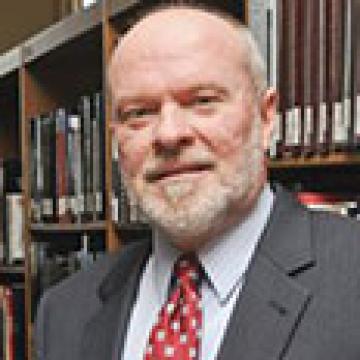
Stephen Knott
Professor of National Security Affairs United States Naval War College
More Resources
George h. w. bush presidency page, george h. w. bush essays, life in brief, life before the presidency, campaigns and elections, domestic affairs, foreign affairs (current essay), life after the presidency, family life, impact and legacy.
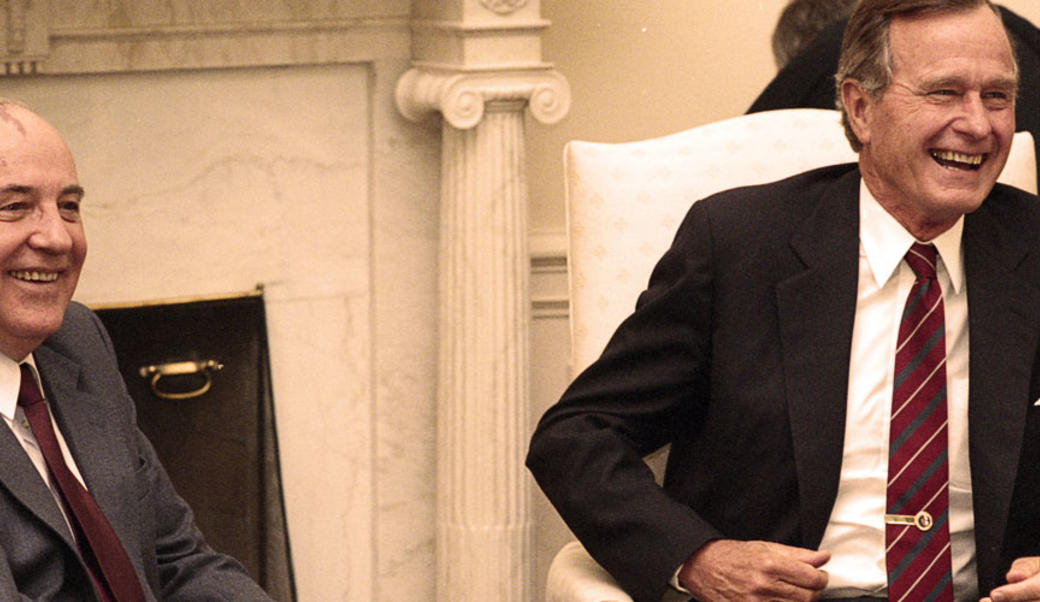

IMAGES
VIDEO
COMMENTS
Bush was 17 years old, and Barbara was just 16. They married in January 1945. On his 18th birthday, Bush enlisted in the U.S. Navy, becoming the youngest pilot in the Navy during World War II. He ...
In fact, George H. W. and George W. are only the second set of father and son to become President. (John Adams and John Quincy Adams were the first.) Bush was born and raised in New England in a wealthy family. His parents valued hard work and public service and were strong influences in his life. He was educated at Phillips Academy Andover ...
George H. W. Bush. George Herbert Walker Bush [a] (June 12, 1924 - November 30, 2018) was an American politician, diplomat, and businessman who served as the 41st president of the United States from 1989 to 1993. [2] A member of the Republican Party, he also served as the 43rd vice president from 1981 to 1989 under Ronald Reagan, and in ...
The biography for President Bush and past presidents is courtesy of the White House Historical Association. George H. W. Bush, as the 41st President (1989-1993), brought to the White House a ...
Born on June 12, 1924, in Milton, Mass., George Bush became a decorated naval pilot who flew torpedo bombers during World War II. He was shot down on September 2, 1944 while completing a mission over Chi Chi Jima Island and, tragically, lost his two crewmen William "Ted" White and John Delaney. By the time he was honorably discharged in ...
George H.W. Bush, (born June 12, 1924, Milton, Mass., U.S.—died Nov. 30, 2018, Houston, Texas), 41st president of the U.S. (1989-93).Bush was the son of Prescott Bush, an investment banker and U.S. senator from Connecticut. He served in World War II as a torpedo bomber pilot on aircraft carriers in the Pacific, flying some 58 combat missions; he was shot down by the Japanese in 1944.
Born in 1924 to a prominent New England family, George Herbert Walker Bush enjoyed a privileged childhood and a close-knit family. Later in life, Bush would say, "Family is not a neutral word for ...
George Herbert Walker Bush belongs to a political dynasty; he sits in the middle of three generations of politicians, including his father Prescott, a senator from Connecticut; his son Jeb, former governor of Florida; and his son, George Walker, the 43rd President of the United States. In fact, George H. W. and George W. are only the second set ...
George H. W. Bush: Impact and Legacy. By Stephen Knott. George Herbert Walker Bush came into the presidency as one of the most qualified candidates to assume the office. He had a long career in both domestic politics and foreign affairs, knew the government bureaucracy, and had eight years of hands-on training as vice president.
LULU GARCIA-NAVARRO, HOST: We're remembering the life of George H.W. Bush this morning. The 41st president died Friday evening. He's remembered as a president, the father of a president, and a ...
President George H.W. Bush has died at the age of 94. We look back on his life and legacy. SCOTT SIMON, HOST: President George Herbert Walker Bush has died at his home in Houston. He was 94. The ...
George H. W. Bush 's tenure as the 41st president of the United States began with his inauguration on January 20, 1989, and ended on January 20, 1993. Bush, a Republican from Texas and the incumbent vice president for two terms under President Ronald Reagan, took office following his victory over Democratic nominee Michael Dukakis in the 1988 ...
Description. A brief summary of the life and career of George H.W. Bush. Bell Ringer Assignment. When was George H.W. Bush born? Describe his family life.
This publication contains a short biography of every member of Congress from 1774 to the present, including George H. W. Bush, who served in the House of Representatives in the 90th and 91st Congresses (January 3, 1967-January 3, 1971). George H.W. Bush Presidential Library and Museum is part of the Presidential Library system administered by ...
George H.W. Bush - Cold War, Diplomacy, Leadership: Upon assuming office, Bush made a number of notable senior staff appointments, among them that of Gen. Colin Powell to chairman of the U.S. Joint Chiefs of Staff. His other important policy makers included James Baker as secretary of state and William Bennett as director of the Office of National Drug Control Policy.
Biography of President George W. Bush. George W. Bush is the 43rd President of the United States. He was sworn into office on January 20, 2001, re-elected on November 2, 2004, and sworn in for a second term on January 20, 2005. Prior to his Presidency, President Bush served for 6 years as the 46th Governor of the State of Texas, where he earned ...
Personal Life & Legacy. George H. W. Bush married Barbara Pierce in 1945 and the couple had six children, namely, George W. Bush, Robin Bush, Jeb Bush, Neil Bush, Marvin P. Bush and Dorothy Bush Koch. George H. W. Bush and Barbara Bush were married for 73 years till the death of Barbara Bush on April 17, 2018.
In numerous ways, George H.W. Bush seems to have spent his life preparing for the presidency. A man of almost supernatural decency, Bush was the oldest-ever living president until his death thirty-eight days ago at the age of 94. (With fair winds and following seas, Jimmy Carter will inherit that title in just over ten….
George W. Bush: Life in Brief. By Gary L. Gregg II. George W. Bush, the 43rd President of the United States, led the country during a time of great challenge and change. The terrorist attacks of September 11, 2001, the global war on terror, the war in Iraq, and the economic downturn of 2008 are just some of the major events that Bush had to ...
George Bush was the 41st President of the United States. Served as President: 1989-1993 Vice President: Dan Quayle Party: Republican Age at inauguration: 64 Born: June 12, 1924 in Milton, Massachusetts Died: November 30, 2018 (aged 94) Houston, Texas Married: Barbara Pierce Bush Children: George, Robin, John, Neil, Marvin, Dorothy Nickname: Poppy, Chief Spook ...
Bush was the eldest of six children of George H.W. Bush, who served as the 41st president of the United States (1989-93), and Barbara Bush.His paternal grandfather, Prescott Bush, was a U.S. senator from Connecticut (1952-63). The younger Bush grew up largely in Midland and Houston, Texas.From 1961 to 1964 he attended Phillips Academy in Andover, Massachusetts, the boarding school from ...
Jean Becker spent 25 years as chief of staff for the late former President George H.W. Bush after he left the White House. She was a USA Today reporter who met Bush's wife Barbara while editing ...
One example of Bush's conservative and pragmatic approach to foreign affairs occurred early in his administration. In June 1989, the Chinese military suppressed a pro-democracy movement demonstrating in Beijing's Tiananmen Square. Using tanks and armored cars, the military crushed the demonstrations and fired into the crowd, killing hundreds of ...